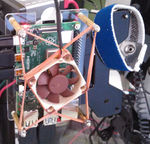Cooling - Raspberry Pi
Pi 4
The video core GPU temperature can be read with the use of the terminal and the below command:
vcgencmd measure_temp
The Raspberry Pi4 starts to throttle at 80c, and will be fully throttled when it hits 85. When flying the DC-3 Dakota at a steady cruse altitude, in a low scenery dense area, the core temperature was reported to be ~75c. This was with ambient temperature of ~24c. The temperature rapidly dropped to ~45c when the cooling fan was energized. There was no heat sink installed for this test. FlightGear was running in fullscreen mode on monitor 1 and terminal was running on monitor 2. Screen resolution was possibly 1024 x 768.
The fan in the photo is a Noctua NF-A4x10 5V. It is installed with two rubber bands forming an X. Then the fan is simply sandwiched in the middle of the X. The ends of the rubber bands are looped over the ends of the four standoffs. The rubber bands, in addition to holding the fan, help to isolate vibrational noise. In this setup the fan was powered by an orphaned cell phone charger.
There are also inexpensive heat sink kits. Some opt for no after market cooling options at all, however it has been reported the the Pi4 will self cool the best when placed/mounter in the vertical direction.
Pi 400
The Raspberry Pi 400 has a large multi purpose plate of aluminum under the keyboard. This is for strength, electrical noise shielding and an effective heat sink. There is no need for extra cooling, even during long periods of program compiling.
